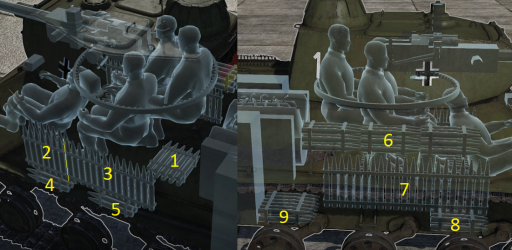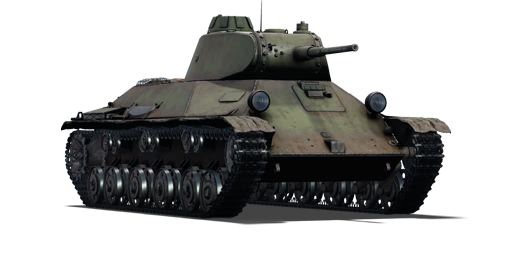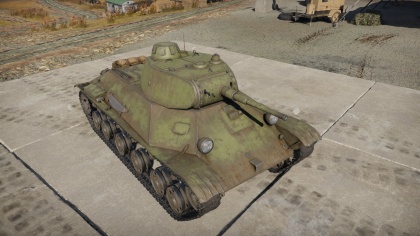Difference between revisions of "T-50"
| Line 1: | Line 1: | ||
| − | {{Specs-Card|code=ussr_t_50}} | + | {{Relevance|br}}{{Specs-Card|code=ussr_t_50}} |
== Description == | == Description == | ||
| Line 5: | Line 5: | ||
[[File:GarageImage_T-50.jpg|420px|thumb|left]] | [[File:GarageImage_T-50.jpg|420px|thumb|left]] | ||
{{break}} | {{break}} | ||
| − | The '''{{ | + | The '''{{Specs|name}}''' is a rank {{Specs|rank}} Soviet light tank {{Battle-rating}}. It was introduced during the Closed Beta Test for Ground Forces before Update 1.41. It is an effective light tank with great sloping armour and an adequate 45 mm cannon, a great vehicle for beginners getting used to the Soviet play style in higher ranks. |
As a light tank, the T-50 is very agile and it has a very high top speed and HP ratio, due to this ratio the acceleration on the T-50 is outstanding; 60 Km/h in about 6 seconds Off-road. It mounts the same gun as the [[T-26|T-26]] but compensates for lack of penetration with the ability to use APCR shells. It has excellent armour for a light tank and it's sloping makes it very effective, especially if angled properly, though its hull cheeks are somewhat vulnerable. Use its agility coupled with the excellent armour to perform flanking manoeuvres, destroy enemy tanks and retreat quickly. It is often used in tier 2 battles for its versatility as an aggressive scout tank. | As a light tank, the T-50 is very agile and it has a very high top speed and HP ratio, due to this ratio the acceleration on the T-50 is outstanding; 60 Km/h in about 6 seconds Off-road. It mounts the same gun as the [[T-26|T-26]] but compensates for lack of penetration with the ability to use APCR shells. It has excellent armour for a light tank and it's sloping makes it very effective, especially if angled properly, though its hull cheeks are somewhat vulnerable. Use its agility coupled with the excellent armour to perform flanking manoeuvres, destroy enemy tanks and retreat quickly. It is often used in tier 2 battles for its versatility as an aggressive scout tank. | ||
Revision as of 11:41, 7 May 2020
| Battle Ratings/Ranks subject to change The battle ratings and/or ranks depicted on this article may be outdated due to a recent update. They will be updated soon. |
Contents
Description
The T-50 is a rank II Soviet light tank
with a battle rating of 2.7 (AB/RB/SB). It was introduced during the Closed Beta Test for Ground Forces before Update 1.41. It is an effective light tank with great sloping armour and an adequate 45 mm cannon, a great vehicle for beginners getting used to the Soviet play style in higher ranks.
As a light tank, the T-50 is very agile and it has a very high top speed and HP ratio, due to this ratio the acceleration on the T-50 is outstanding; 60 Km/h in about 6 seconds Off-road. It mounts the same gun as the T-26 but compensates for lack of penetration with the ability to use APCR shells. It has excellent armour for a light tank and it's sloping makes it very effective, especially if angled properly, though its hull cheeks are somewhat vulnerable. Use its agility coupled with the excellent armour to perform flanking manoeuvres, destroy enemy tanks and retreat quickly. It is often used in tier 2 battles for its versatility as an aggressive scout tank.
The armour is especially capable at stopping rounds when facing US 37 mm and German 50 mm cannons, which will bounce fairly easily even without proper angling. The gun is also excellent for a 2.7 tank, having a fairly high velocity combined with a good HE filler amount and a very fast fire rate which makes follow up/corrective shots easy and lethal.
Unfortunately, there is one major flaw with the T-50- the turret traverse. It has a very slow traverse rate which makes up-close urban encounters very
Most new tankers will quickly become used to the T-50 due to its forgiving armour, mobility, and fast-firing gun. Basically, the T-50 is a mini T-34 and should be played as such- as a close range brawler.
General info
Survivability and armour
Armour type:
- Rolled homogeneous armour
- Cast homogeneous armour (Cupola)
| Armour | Front | Sides | Rear | Roof |
|---|---|---|---|---|
| Hull | 40 mm (53°) Front glacis 40 mm (55-56°) Cheeks 45 mm (54°) Lower glacis |
40 mm (40°) Top 40 mm (1°) Bottom |
25 mm (59°) Top 40 mm (9-28°) Bottom |
15 mm |
| Turret | 40 mm (13-64°) Turret front 40 mm (23-54°) Gun mantlet |
40 mm (16-19°) | 15 mm (13-15°) | 15 mm |
| Armour | Sides | Roof | ||
| Cupola | 40 mm | 15 mm |
Notes
- Suspension wheels and tracks are 15 mm thick in armour.
Like its big brother, the T-34, the T-50 has sloped frontal armour that can bounce most shots if angled properly. Additionally, there aren't many vital components (ammo rack, fuel tank, majority of the crew, etc.) in the front. Firing at the front will, at best, knock out the driver and immobilize the tank. However, the gun will still be operational and the T-50's gun is more than capable of defeating opponents at its level. Therefore, it is best to aim for other parts of the tank.
The advice for defeating a T-50 is similar to many other tanks: flank it and hit the sides. This is easier said than done, of course, as the T-50 demonstrates excellent mobility, but with the right amount of sneaking around, it can be done. Both sides of the tank contain juicy ammo racks that are hard to miss if the tank's sides are hit, but more experienced drivers will know to empty the left wall. Therefore, it is advised to fire at the right side of the tank if possible.
If the right side is angled at an impenetrable angle, or if it simply is too difficult to hit, the next best target is the turret. Hitting it anywhere on the turret is likely to, upon penetration, wound if not knock out the three crew inside the turret. Combined with the T-50's subpar turret traverse, the T-50 will be in dire straits if its turret is hit. Make sure to fire at the tracks with secondary armament, if possible, to immobilize the tank so anyone could dispatch it with leisure.
Mobility
| Game Mode | Max Speed (km/h) | Weight (tons) | Engine power (horsepower) | Power-to-weight ratio (hp/ton) | |||
|---|---|---|---|---|---|---|---|
| Forward | Reverse | Stock | Upgraded | Stock | Upgraded | ||
| Arcade | 58 | 8 | 14 | 465 | 572 | 33.21 | 40.86 |
| Realistic | 53 | 7 | 265 | 300 | 18.93 | 21.43 | |
Armaments
Main armament
| 45 mm 20-K | |||||
|---|---|---|---|---|---|
| Capacity | Vertical guidance |
Horizontal guidance |
Stabilizer | ||
| 150 | -7°/+25° | ±180° | N/A | ||
| Turret rotation speed (°/s) | |||||
| Mode | Stock | Upgraded | Prior + Full crew | Prior + Expert qualif. | Prior + Ace qualif. |
| Arcade | 4.80 | 6.60 | _.__ | _.__ | _.__ |
| Realistic | 4.80 | 5.60 | _.__ | _.__ | _.__ |
| Reloading rate (seconds) | |||||
| Stock | Prior + Full crew | Prior + Expert qualif. | Prior + Ace qualif. | ||
| 3.80 | _.__ | _.__ | _.__ | ||
Ammunition
| Penetration statistics | |||||||
|---|---|---|---|---|---|---|---|
| Ammunition | Type of warhead |
Penetration in mm @ 90° | |||||
| 10m | 100m | 500m | 1000m | 1500m | 2000m | ||
| BR-240 | APHEBC | 69 | 68 | 59 | 50 | 42 | 35 |
| BR-240SP | AP | 73 | 71 | 62 | 52 | 44 | 37 |
| BR-240P | APCR | 103 | 94 | 64 | 40 | 21 | 17 |
| Shell details | ||||||||||
|---|---|---|---|---|---|---|---|---|---|---|
| Ammunition | Type of warhead |
Velocity in m/s |
Projectile Mass in kg |
Fuse delay
in m: |
Fuse sensitivity
in mm: |
Explosive Mass in g (TNT equivalent): |
Normalization At 30° from horizontal: |
Ricochet: | ||
| 0% | 50% | 100% | ||||||||
| BR-240 | APHEBC | 760 | 1.4 | 1.2 | 15 | 32.3 | +4° | 48° | 63° | 71° |
| BR-240SP | AP | 757 | 1.4 | N/A | N/A | N/A | -1° | 47° | 60° | 65° |
| BR-240P | APCR | 985 | 0.85 | N/A | N/A | N/A | +1.5° | 66° | 70° | 72° |
Ammo racks

| Full ammo |
1st rack empty |
2nd rack empty |
3rd rack empty |
4th rack empty |
5th rack empty |
6th rack empty |
7th rack empty |
8th rack empty |
9th rack empty |
Visual discrepancy |
|---|---|---|---|---|---|---|---|---|---|---|
| 150 | 133 (+17) | 117 (+33) | 100 (+50) | 83 (+67) | 66 (+84) | 49 (+101) | 33 (+117) | 17 (+133) | 1 (+149) | Yes |
Left wall empty: 100 (+50)
Machine guns
| 7.62 mm DT | ||||||
|---|---|---|---|---|---|---|
| Coaxial mount (x2) | ||||||
| Capacity (Belt capacity each) | Fire rate (shots/minute) |
Vertical guidance |
Horizontal guidance | |||
| 3,780 (63) | 600 | N/A | N/A | |||
Usage in the battles
Flank, flank, flank. The T-50 should be played like an up-armoured BT-5 due to its high speed and good armour.
The entire Pz. III line equipped with 50 mm guns which are especially deadly from the side/front, as their APHE shells combined with high velocity/fire rate and fairly good armour make for difficult opponents. However, Pz.IIIs have much worse mobility and armour - take advantage of this.
Pros and cons
Pros:
- Great mobility
- Decent penetration and good rate of fire
- Excellent armour
- Provides a good learning curve for the later T-34 1940
- Unlike the BT-tanks, the T-50 can be driven with some precision
- It is easy to rush an enemy tank and catch them by surprise, giving a first shot advantage
- 45 mm shell has HE filler making it much more effective than the comparable shells in the US 37mms and British QF 40 mm cannons
- Unlike most tanks, it has two 7.62 mm machineguns in the turret. This allows for more effective combat against SPAA and low flying aircraft
Cons:
- Penetration can be found wanting with the APHE shell, though generally not an issue
- The high speed makes it easy to damage the tracks, especially the first few times driving this tank
- The cannon mantlet can be easily penetrated even by starter tanks
- Slow turret traverse speed
- Cramped interior, one penetration can knock out the majority of the crew
History
Development
The Spanish Civil War gave the Soviets insight on the future of tank warfare, and the knowledge led to an attempt to upgrade or replace their tank forces that consisted mainly of the T-26 light tanks. The development started in 1939 to create a replacement for the T-26 and BT light tanks.
The prototypes created for this development were the T-126 and T-127, which were similar to a previous T-46-5 project earlier abandoned. The T-126 was selected for further development and was to have two prototypes built and tested in Leningrad after the original design bureau was decimated by Stalin's Great Purge.
The design, now finalised as the T-50 light tank, used innovative features in its introduction, using well-sloped welded armour, a torsion-bar suspension, diesel engine, a commander's cupola, and a three-man turret. It was also arranged for all of the tanks to accommodate radios. The T-50's design plan was completed by January 1941, and production was authorised after setting up in April. However, technical difficulties prevented this from happening. While its production was on standby, another tank with superior specifications was being tested and produced, which will end up as the T-34 medium tank.
Production
Though production was planned for in 1941, the Germans launched Operation Barbarossa in June 1941, which delayed the T-50 productions as tank manufacturing lines were relocated. Tanks were being produced in the Urals and that included the T-50 light tanks, finally in production. While an excellent design, it was mechanically unreliable, expensive, and hard to produce compared to the T-34 and another light tank design, the T-60. Because of these issues, only 69 T-50s were made before production ended in January 1942. During production, two variants were made, a basic model and an up-armoured model with extra bolted or welded metal plates. The basic model had a 37 mm frontal armour thickness, while the up-armoured version could have 57 mm thickness.
Combat usage
Despite the low numbers, the ones available were sent to Leningrad where they saw most of their service. Some were also used in the Continuation War against Finland as the Finnish were able to capture one up-armoured version in 1944. After that, its role was largely replaced by the more numerous and capable T-34 tanks, and it was relegated to reconnaissance roles when available.
Today, two T-50 tanks survive, one basic in the Kubinka Tank Museum, and the up-armoured variant in Finland at a museum in Parola.
In-game description
This tank was developed in 1940 to replace the Т-26 light tank, whose main task was direct infantry support on the battlefield. The T-50 was solidly armoured, well armed and equipped with a powerful diesel engine. It had a classical layout, with the driving and fighting compartments in the front of the vehicle and the engine transmission compartment in the rear. The armour plating on its hull was sloped at a steep angle. Its streamlined turret was fully welded. The tank seated three crew. The rear of the turret's roof contained a command cupola with seven observation slots protected by armoured hatches. The vehicle was armed with a 45 mm 20K Mod. 1938 cannon and two 7.62 mm DT coaxial machine guns.
Thanks to its 300 hp B-4 diesel engine, the vehicle's road speed came to 52 km/h in spite of its 13.8 tonne mass. Two fuel tanks with an overall capacity of 350 litres gave it an operational range of up to 344 km by road. Road wheels with internal cushioning and torsion-bar suspension were mounted in the tank's undercarriage.
These tanks were mass-produced by factory No. 174. Between July 1941 and February 1942, 69 of these tanks were built. The tank's construction was far more complicated than that of the T-26. The inline six-cylinder diesel engine designed for it was very difficult for the industry to adopt into its manufacturing processes.
The T-50 was primarily used on the Leningrad front. Several tanks were equipped with add-on armour plates during field maintenance. During the battles of 1941, one vehicle was captured by Finnish troops and was used right up to the end of 1954.
The tank turned out to be functionally designed and well balanced, with overall optimal combat and service characteristics. Its armament, armour and mobility were equal to the German PzKpfw III medium tank, and it had significantly smaller dimensions and lower combat-loaded weight.
Media
An excellent addition to the article will be video guides, as well as screenshots from the game and photos.
Read also
Sources
Paste links to sources and external resources, such as:
- topic on the official game forum;
- other literature.
| USSR light tanks | |
|---|---|
| T-26 | T-26 · T-26 (1st Gv.T.Br.) · T-26-4 · T-26E |
| BT | BT-5 · RBT-5 · BT-7 · BT-7 TD · BT-7M · BT-7A (F-32) |
| T-50 | T-126 · T-50 |
| T-70 | T-70 · T-80 |
| PT-76 | PT-76B · PT-76-57 · Object 906 |
| BMP | BMP-1 · BMP-2 · BMP-2M · BMP-3 |
| BMD | BMD-4 |
| 2S25 | 2S25 · 2S25M |
| Wheeled | BA-11 · BTR-80A |
| Other | T-60 · Object 685 · 2S38 |
| China | ▂Type 62 |





